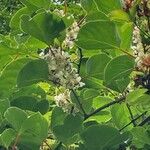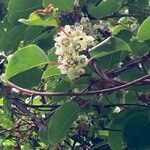Climbing shrubs, large, deciduous. Branchlets glabrous or rarely puberulent, tomentose when young, 7-15 cm; second-year branches grayish brown, glabrous, lenticels absent when young, small and inconspicuous when old; pith white to brown, lamellate. Petiole pinkish brown, 3-6(-10) cm, glabrous, sometimes rusty tomentose or setose; leaf blade abaxially green, adaxially dark green, usually ovate to broadly ovate to suborbicular, sometimes ovate-oblong, 6-12 × 5-10 cm, membranous to papery, abaxially glabrous to rusty tomentose to strigillose especially on midvein and lateral veins, barbate in axils of lateral veins or not, adaxially glabrous, midvein and lateral veins conspicuous abaxially, subconspicuous adaxially, lateral veins 5-7 pairs, straight or arcuate-ascending, anastomosing, veinlets reticulate, subconspicuous abaxially, inconspicuous adaxially, base rounded to cordate, rarely broadly cuneate, symmetrical or oblique, margin sharply serrate, apex abruptly acuminate. Inflorescences cymose, axillary or lateral, 1-7-flowered, brown to pale brown tomentose; peduncles 7-10 mm; pedicels 0.8-1.4 cm; bracts linear, 1-4 mm. Flowers greenish yellow or white, 1.2-2 cm in diam. when fully open. Sepals 4-6, ovate to oblong, 3.5-5 mm, margin ciliate, both surfaces glandular-tomentose, or abaxially slightly puberulent or glabrous. Petals 4-6, cuneate-obovate to orbicular-obovate, 7-9 mm. Filaments silky, 1.5-3 mm; anthers black or dark purple, oblong, 1.5-2 mm, sagittate at base. Ovary bottle-shaped, 6-7 mm, glabrous; styles 3.5-4 mm. Fruit greenish yellow or purple-red when mature, globose to oblong, 2-3 cm, rostrate or inconspicuously so, glabrous, lenticels and persistent sepals absent. Seeds ca. 2.5 mm. Fl. Apr, fr. Aug-Oct. 2n = 58, 116*, 174, 232.
More
A vine up to 15-20 m long. It loses its leaves during the year. Leaves are elongated or heart-shaped and 5-13 cm long. They are light green and have toothed edges. They are attached to the stem by red petioles. The leaves turn rich golden colour in autumn. The fruit are green and 2-3 cm long. The skin is green. It has few hairs. Male and female plants are borne on separate plants. Both are needed for fruit production. Flowers are about 1 cm across. Fruit are dull green and lime-green flesh. They are edible.


